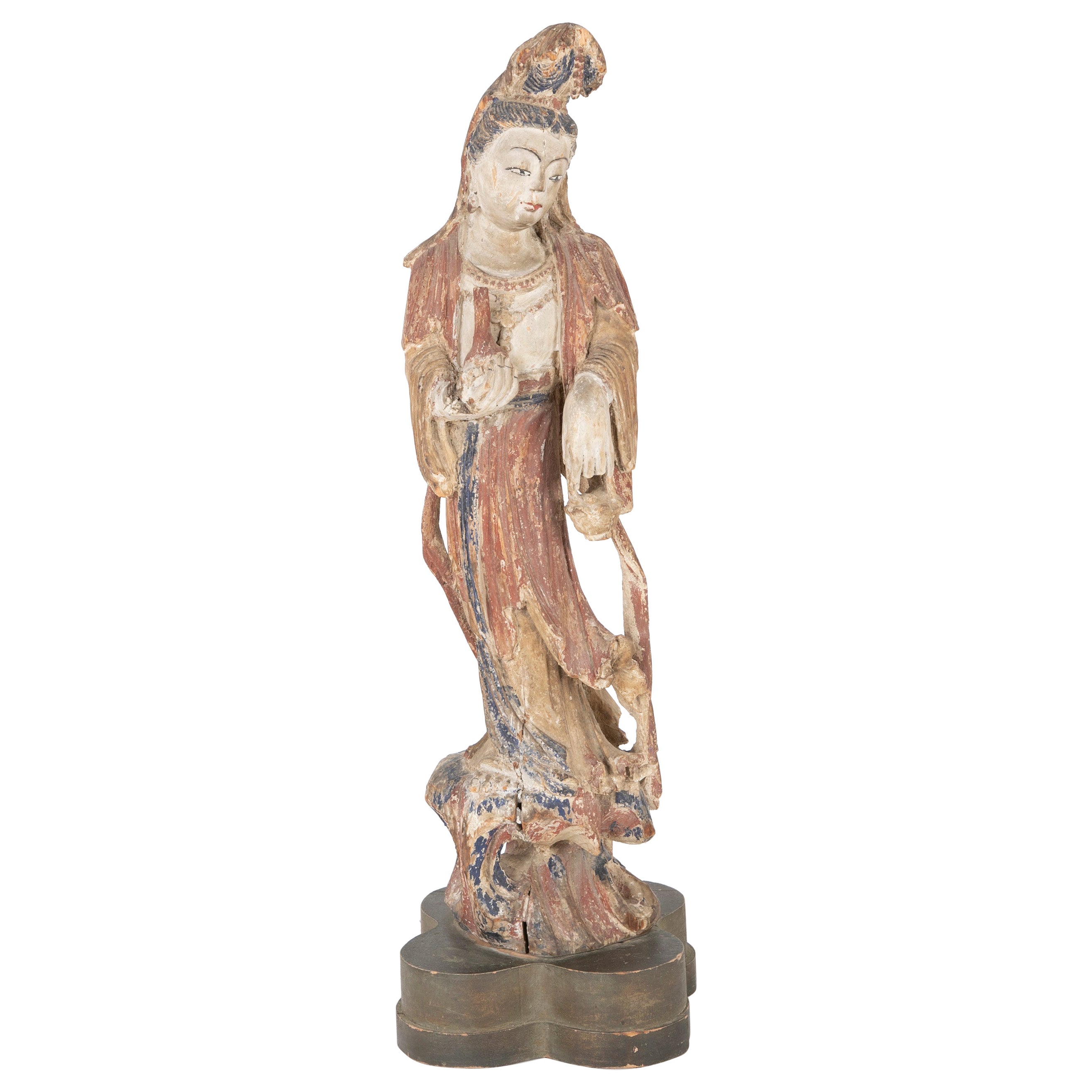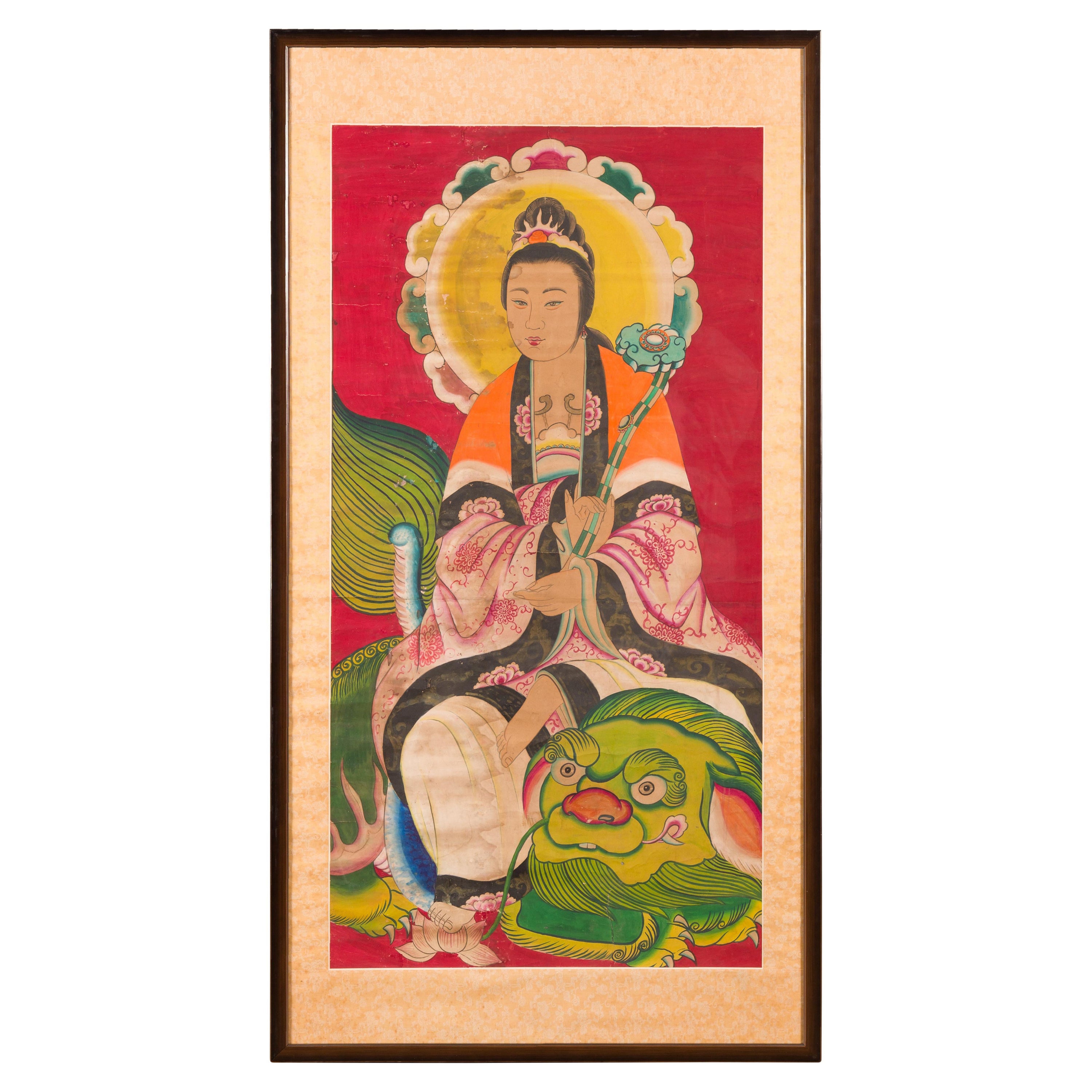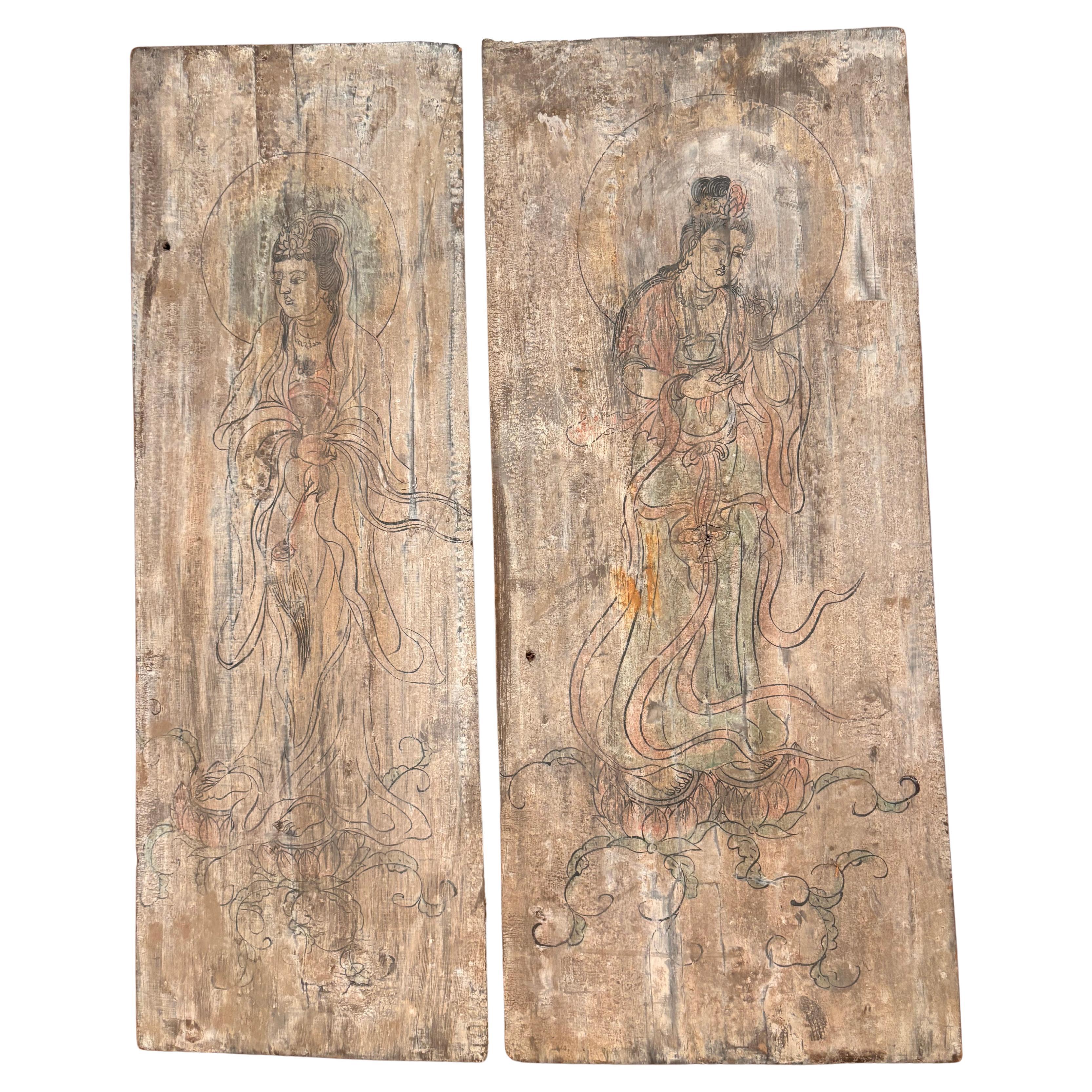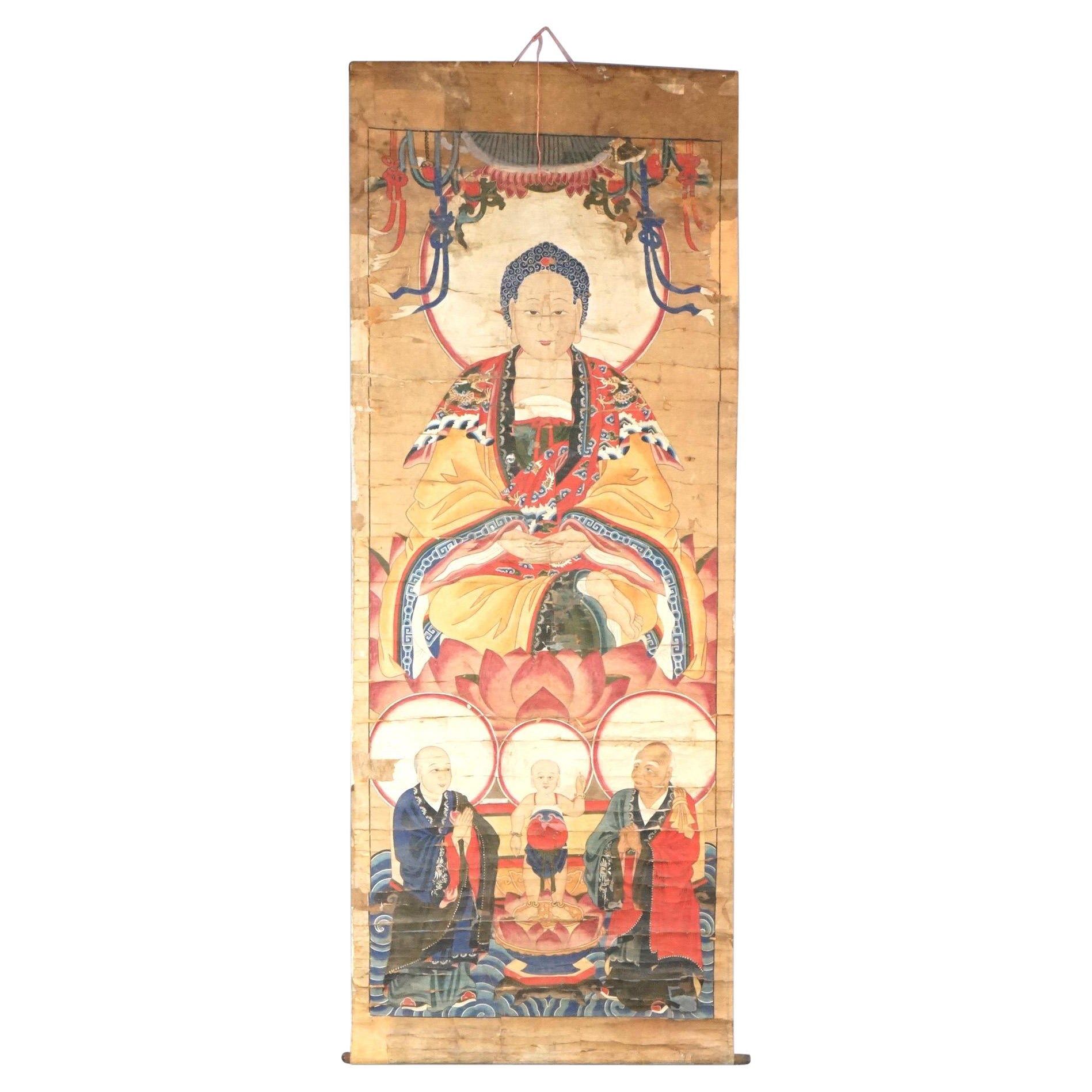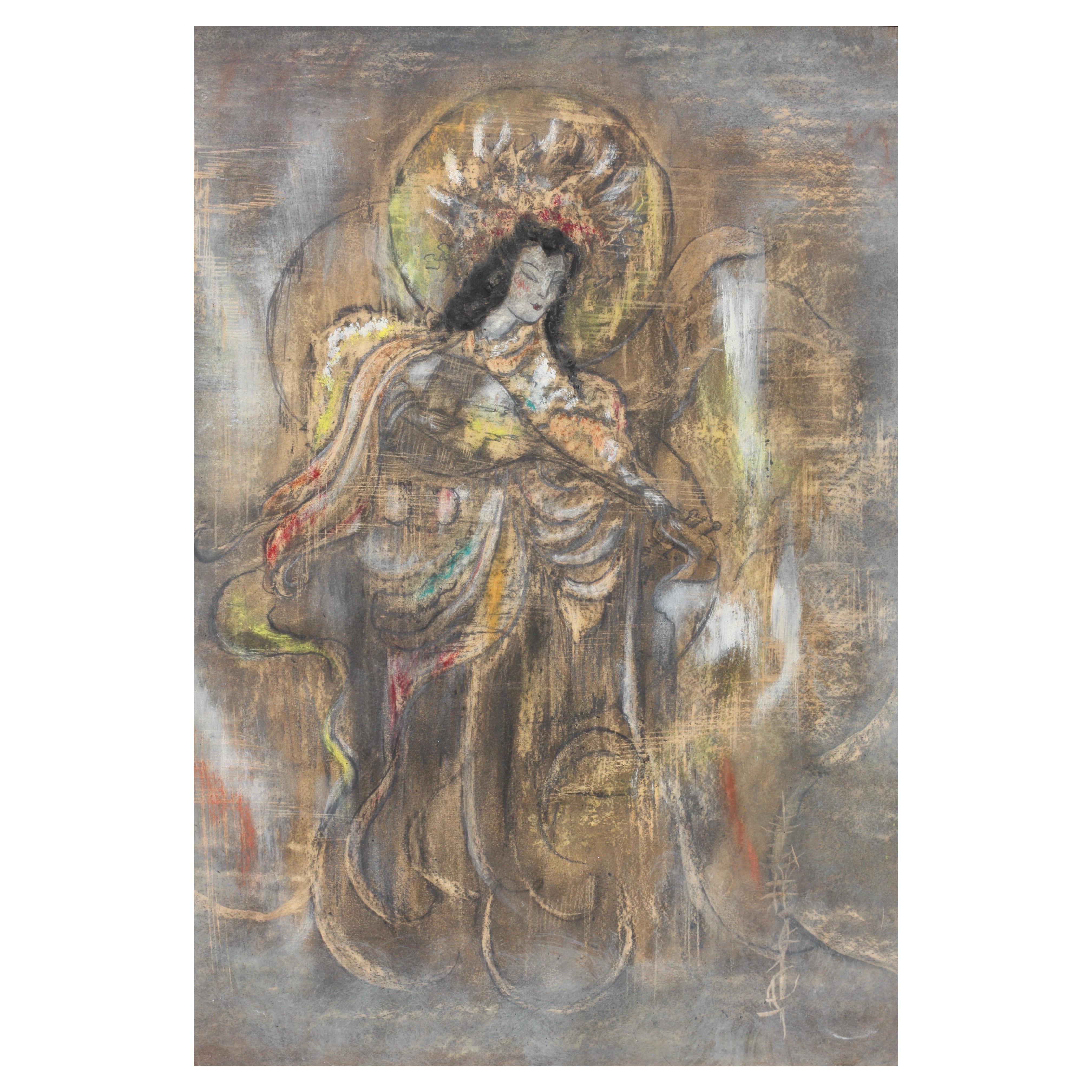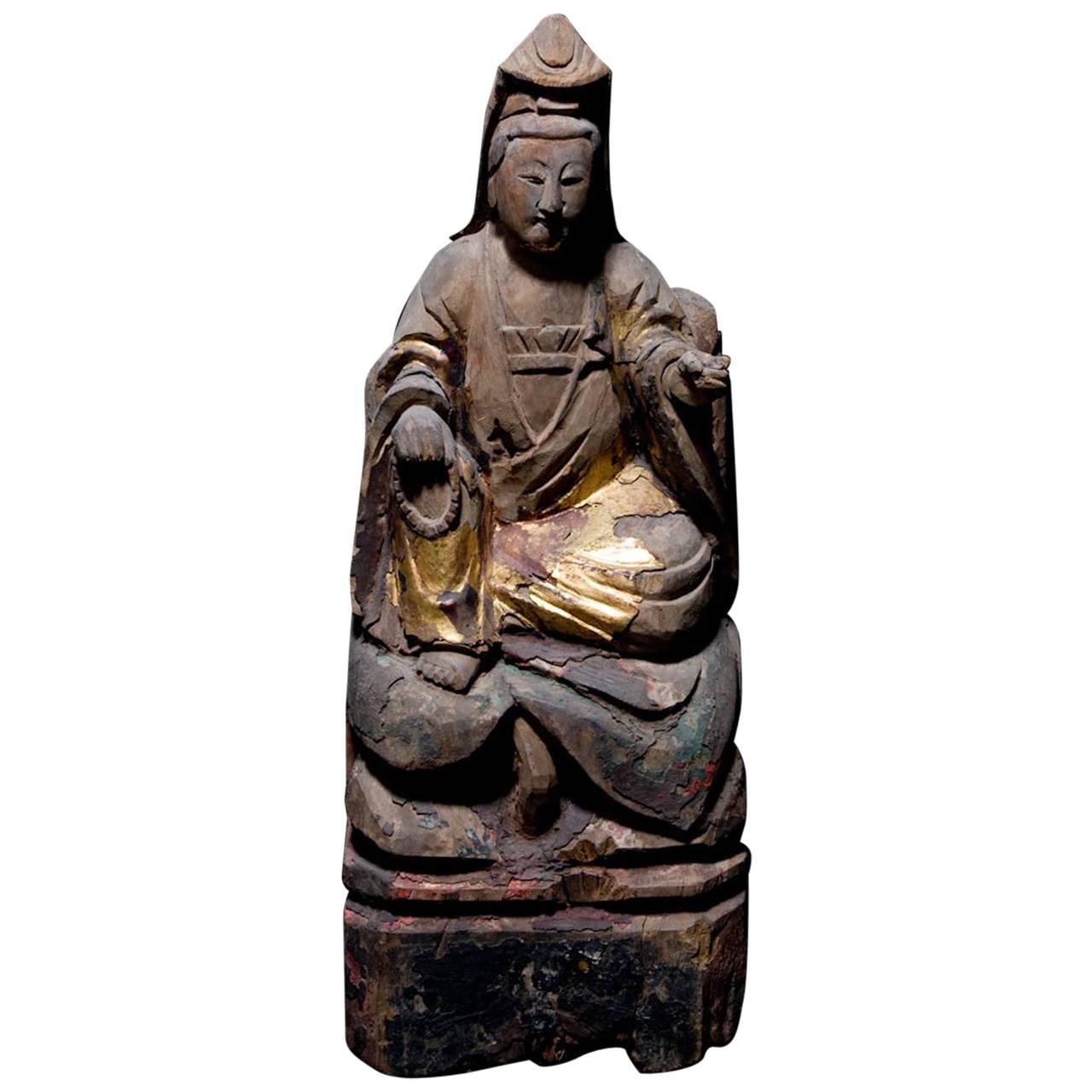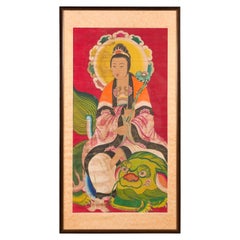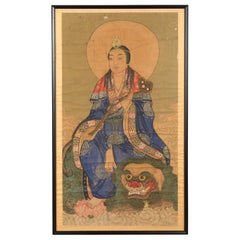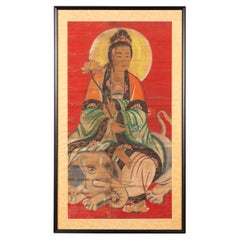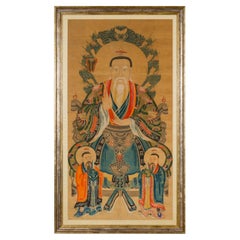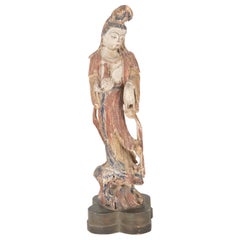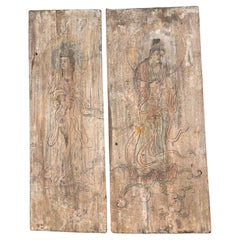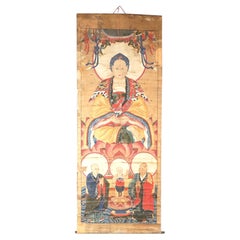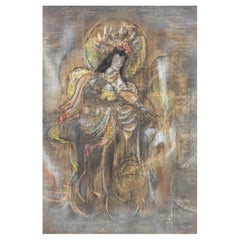Items Similar to Large Two-Sided Painted Elmwood Divider Screen Depicting Guanyin and Zhong Kui
Want more images or videos?
Request additional images or videos from the seller
1 of 15
Large Two-Sided Painted Elmwood Divider Screen Depicting Guanyin and Zhong Kui
$18,500
£14,051.21
€16,161.46
CA$25,848.13
A$28,823.59
CHF 15,038.92
MX$353,676.26
NOK 191,421.47
SEK 181,367.68
DKK 120,618.93
Shipping
Retrieving quote...The 1stDibs Promise:
Authenticity Guarantee,
Money-Back Guarantee,
24-Hour Cancellation
About the Item
An antique Chinese unusual large hand painted two-sided elm divider depicting Guanyin and Zhong Kui, from the first half of the 20th century. This antique Chinese large hand-painted two-sided elm divider, circa 1920-1930, captivates with its unusual and striking visual appeal. The screen features two vibrant scenes, each unfolding against a rich, dark brown background that enhances the painted imagery's depth and detail. On one side, the revered Guanyin, bodhisattva of compassion, is depicted seated serenely on a rock near a flowing river, surrounded by elements of natural beauty that symbolize peace and enlightenment. The opposing side presents the formidable figure of Zhong Kui, the vanquisher of ghosts and evil beings, seen trampling demons with a dynamic stance, reflecting his strength and protective power.
Intricate calligraphy embellishes the right side of Zhong Kui's composition, offering an added layer of cultural significance and artistic finesse. The bold use of color and the skillful brushwork bring both figures to life, making this screen not just a functional divider but a magnificent work of art.
With its impressive size and masterful execution, this Chinese two-sided painted divider screen would serve as a dramatic focal point in any room, whether displayed against a wall or used to define spaces within a larger area. Its exquisite details and duality make it an ideal piece for introducing exotic elegance and a sense of history to a living room, hallway, or study.
- Dimensions:Height: 61 in (154.94 cm)Width: 61 in (154.94 cm)Depth: 1 in (2.54 cm)
- Materials and Techniques:
- Place of Origin:
- Period:
- Date of Manufacture:circa 1920
- Condition:Wear consistent with age and use. Minor losses. Minor fading. Nice aging throughout, the panel is wired on the side of Zhong Kui. Please refer to the various additional photos for further condition detail and contact us with any questions!
- Seller Location:Yonkers, NY
- Reference Number:Seller: YN5684 / FEA Home1stDibs: LU863921892702
About the Seller
5.0
Platinum Seller
Premium sellers with a 4.7+ rating and 24-hour response times
Established in 1968
1stDibs seller since 2009
1,158 sales on 1stDibs
Typical response time: <1 hour
- ShippingRetrieving quote...Shipping from: Yonkers, NY
- Return Policy
Authenticity Guarantee
In the unlikely event there’s an issue with an item’s authenticity, contact us within 1 year for a full refund. DetailsMoney-Back Guarantee
If your item is not as described, is damaged in transit, or does not arrive, contact us within 7 days for a full refund. Details24-Hour Cancellation
You have a 24-hour grace period in which to reconsider your purchase, with no questions asked.Vetted Professional Sellers
Our world-class sellers must adhere to strict standards for service and quality, maintaining the integrity of our listings.Price-Match Guarantee
If you find that a seller listed the same item for a lower price elsewhere, we’ll match it.Trusted Global Delivery
Our best-in-class carrier network provides specialized shipping options worldwide, including custom delivery.More From This Seller
View AllLarge Framed Indian 19th Century Painting of Guanyin Sitting on a Dragon
Located in Yonkers, NY
An antique Indian painting from the 19th century depicting Guanyin the Bodhisattva of Compassion sitting on a dragon. Created in India during the 19th century, this large painting features Guanyin the Bodhisattva of Compassion, sitting on the head of a dragon. Her right foot on a lotus flower, Guanyin wears an ornate headdress and elegant clothes. The painting itself measures 27.5"W x 53.5" H and has been set inside a custom frame. With its vivid colors and elegant subject, this 19th century Indian painting...
Category
Antique 19th Century Indian Paintings
Materials
Fabric, Plexiglass, Paper
Large Framed Indian 19th Century Painting of Guanyin Sitting on a Dragon
Located in Yonkers, NY
An antique Indian painting from the 19th century depicting Guanyin the Bodhisattva of Compassion sitting on a dragon. Created in India during the 19th century, this large painting features Guanyin the Bodhisattva of Compassion, sitting on the head of a dragon, fluffy clouds adorning the painting's lower section. Her right foot on a lotus flower, Guanyin wears an ornate headdress and elegant clothes. The painting itself measures 30.5"W x 53.5" H and has been set inside a custom frame. Its peaceful subject will make this 19th century Indian painting...
Category
Antique 19th Century Indian Paintings
Materials
Fabric, Plexiglass, Paper
19th Century Indian Print with Guanyin the Bodhisattva of Compassion on Elephant
Located in Yonkers, NY
An antique Indian print from the 19th century depicting Guanyin the Bodhisattva of Compassion. Created in India during the 19th century, this larg...
Category
Antique 19th Century Indian Prints
Materials
Fabric, Plexiglass, Wood, Paper
Taoist Hand-Painted Portrait on Parchment Paper in Custom Frame
Located in Yonkers, NY
A large antique hand-painted Taoist portrait on parchment paper with silk matting, in custom frame. This large antique hand-painted Taoist portrait is a mesmerizing work of art that ...
Category
Antique 19th Century Chinese Qing Paintings
Materials
Composition
Mandarin Taoist Ceremonial Chinese Scroll Portrait Painting in Custom Frame
Located in Yonkers, NY
Mandarin Taoist Chinese ceremonial scroll portrait painting in custom plexiglass frame. Exuding an air of spiritual significance and artistic mastery, this Mandarin Taoist Chinese ce...
Category
Antique 19th Century Chinese Prints
Materials
Plexiglass, Paper
Chinese Qing Dynasty 19th Century Official's Wife Painting on Linen Canvas
Located in Yonkers, NY
A Chinese Qing Dynasty period framed painting from the 19th century of an official's wife with bird-adorned buzi, painted on a linen canvas. Created in the North-Eastern province of Shanxi during the Qing dynasty, this 19th century painting showcases a frontal depiction of an official's wife recognizable thanks to the bird-themed rank badge sitting on an elegant armchair with scrolling arms and carved apron. Wearing a red robe and topped with an ornate headdress, the figure is highlighted with gold foil accents and stands out beautifully on a linen canvas. The print size is 17.5"W x 41.5"H. These paintings traditionally come from Shanxi province which was home to many of the wealthy merchant families associated with the imperial court during the Qing dynasty. Set inside a custom made frame, this 19th century Qing Dynasty official's wife painting...
Category
Antique 19th Century Chinese Paintings
Materials
Canvas, Plexiglass, Wood
You May Also Like
Chinese Carved and Painted Wood Sculpture of Guanyin
Located in Stamford, CT
Beautiful carving of Guanyin, shown standing on a rocky outcrop, mounted on a lobed wooden base. It was once used as a lamp, and can be rewired. Nice faded painted surface.
Guany...
Category
Early 20th Century Chinese Ming Sculptures and Carvings
Materials
Wood
Chinese Pair Buddhist Tang Bodhisattvas Hand Painted Old Wood Plaques
Located in South Burlington, VT
A wonderful Chinese hand painted pair (2) paintings on old wooden panels of Buddhist Bodhisattvas in attractive poses with crown mandorla and long flowing robes. Frame them or mou...
Category
20th Century Chinese Tang Sculptures and Carvings
Materials
Wood
Large Antique Chinese Deity Scroll Painting 19th C
Located in Big Flats, NY
An oversized antique Chinese scroll painting offers depiction of deity with figures, 19th century
Measures - 69" x 26.5"
Catalogue Note: ...
Category
Antique 19th Century Asian Paintings and Screens
Materials
Paper
$760 Sale Price
20% Off
Painting of Guanyin Qing Dynasty 19/20th Century Color on Silk
Located in West Palm Beach, FL
A painting of Guanyin
Qing Dynasty 19/20th century
color on silk;
The deity depicted floating, attired in long robes, adorned with jewels and wearing...
Category
20th Century Paintings and Screens
Materials
Silk
Lady Guanyin Bodhisattva Gilded Wood Carving - Ming Dynasty, China 1368-1644 AD
Located in San Pedro Garza Garcia, Nuevo Leon
Magnificent Lady Guanyin Bodhisattva seated in Royal Relaxation pose hand-carved in Gilded Wood with traces of paint still visible.
This expressi...
Category
Antique 15th Century and Earlier Chinese Ming Antiquities
Materials
Wood
A Large Chinese Carved Wood Figure of Guanyin, Late Qing Dynasty
Located in ARMADALE, VIC
Description:
A fine depiction of Guanyin, possessing the regal tranquillity that the Chinese Bodhisattva of compassion has come to be visually associated with. Marked by an urna signifying her spiritual enlightenment and crowned with a diadem depicting the Buddha Amitabha, the figure is immediately recognisable as Guanyin. Her androgynous figure is gracefully poised in the Lalit asana or “royal ease”, the pose classical in representations of the deity. The figure is asymmetric, with the weight of her supple form falling upon her left hand placed against the base, her right knee raised and left pendant. Her right hand rests upon her raised knee, delicately pinching at her draped attire. At first unassuming, this gesture may be suggestive of the Apana Mudra, the seal of purification. This Mudra is associated with physical wellbeing, fecundity and the cleansing of the body. Though she is adorned in the princely garb of dhoti, she bears features of idealised feminine beauty as prescribed in Asian art. With plump cheeks and near pouted lips, her full face gazes down upon the viewer with an empathetic and half-lidded gaze, upholding her title as ‘One who hears the cries of the world.’
Notes on the item:
Guanyin is the Chinese interpretation of Avalokiteshvara, the Indian Bodhisattva of compassion. The term “Bodhisattva” is derived from the Sanskrit “Bodhi”, meaning ‘awakening’ or ‘enlightenment’, combined with “Sattva”, meaning ‘spirit’ or ‘being’, referring to one on the path to achieving enlightenment. Bodhisattvas in Mayahana Buddhism are recognised as figures who have effectively achieved enlightenment yet relinquish their accension to nirvana in order to remain amongst mankind in the ultimate act of compassion to aid as spiritual guides. As such, the Bodhisattva inhabit a liminal space between samsara and nirvana; enlightened beings that maintain a relationship with humanity that buddhas cannot, as attaining Buddhahood necessitates the abandonment of all worldly attachments, including mankind. Guanyin’s very name, ‘One who hears the cries of the world’ highlights this role as a compassionate figure who acknowledges the suffering and strife of man. Along with Mahāsthāmaprāpta, a fellow bodhisattva, Guanyin serves as an attendant to Buddha Amitabha, with these three deities recognised as the Three Sages of Western Pure Land Buddhism, a sect of Mayahana Buddhism popular in East Asia.
Avalokiteshvara is commonly posited to have been adopted from Indian Buddhism into China as Guanyin around 200-400 CE, however it was the Tang dynasty (618-907) which saw the popularisation of the deity. By the Ming (1358–1644) and Qing (1644–1911) dynasties, Guanyin held the position as the most popular female deity in China. The unique state of religion in China held no monolithic canon regarding Buddhism and saw the assimilation of several belief systems, primarily Daoism, Buddhism and Confucianism. Consequently, Guanyin became a deity to be revered beyond Buddhism alone, appointed as both an official imperial deity and Daoist deity in the 12th century. Guanyin may also be seen to fulfil the role of idealised femininity as prescribed by Confucianism, with the scarcity of female Chinese deities perhaps accounting for the gradual gender shift Guanyin underwent.
The Indian Avalokiteshvara is unequivocally recognised as male, whilst the supposed gender of Guanyin remains contentious. Although there is a clear shift from the masculine Avalokiteshvara towards a more feminine representation, it is unclear if Guanyin is understood to be entirely feminine, to inhabit qualities of both genders or to be elevated beyond gender entirely, embodying neither. Depictions of Guanyin are highly androgynous, which some believe lends credence towards Guanyin symbolising the unity of dualistic forces as recognised in Daoism, displaying the anthropomorphism of yin and yang.
Comparative Analysis:
Market comparisons of similar Qing Dynasty polychrome figures of Guanyin include lot 767 (no.2) From Christies ‘Important Chinese Ceramics and Works of Art,’ New York, 25 March 2022, with the price realised USD 52,920 (Estimate USD 20,000 – USD 30,000). Christies also auctioned a comparable polychrome Guanyin...
Category
Antique Late 19th Century Chinese Qing Sculptures and Carvings
Materials
Hardwood
More Ways To Browse
Large Room Divider
Chinese Screen Painted
Hand Painted Chinese Screen
Large Chinese Screens
Chinese Wall Screens
Elmwood Antique
Bodhisattva Chinese
Chinese Guanyin
Asian Room Divider Screen
Antique Guanyin
Calligraphy
Asian Demon
Guanyin Painting
Zhong Kui
Chinese Screen Painted
Japanese Silk Screens
Asian Gold Leaf Art
Japanese Bamboo Art
